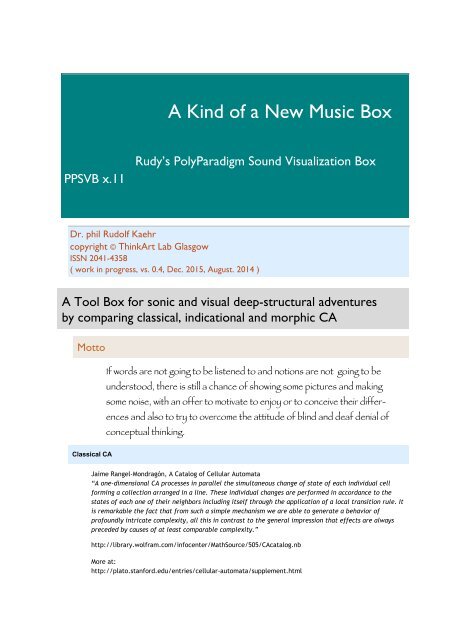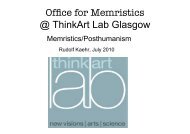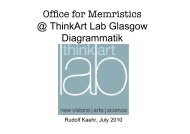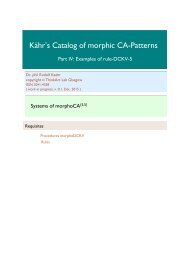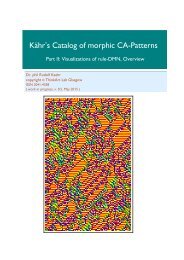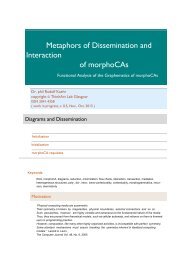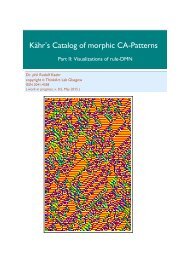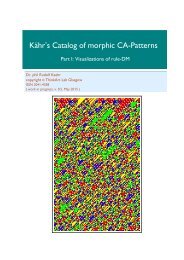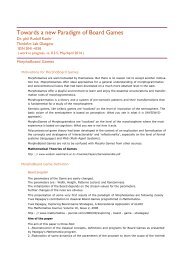A Kind of a New Music Box
A Tool Box for sonic and visual deep-structural adventures by comparing classical, indicational and morphic CA. Motto: If words are not going to be listened to and notions are not going to be understood, there is still a chance of showing some pictures and making some noise, with an offer to motivate to enjoy or to conceive their differences and also to try to overcome the attitude of blind and deaf denial of conceptual thinking. Interactivity for Sound and Visualizations needs the formats Wolfram CDF or HTML. http://www.thinkartlab.com/Memristics/PPSVB-Plus/PPSVB.x11D-Plus.html , soundtracks at: https://soundcloud.com/morphicalgorithms/tracks, more information at: http://the-chinese-challenge.blogspot.co.uk
A Tool Box for sonic and visual deep-structural adventures
by comparing classical, indicational and morphic CA.
Motto:
If words are not going to be listened to and notions are not going to be understood, there is still a chance of showing some pictures and making some noise, with an offer to motivate to enjoy or to conceive their differences and also to try to overcome the attitude of blind and deaf denial of conceptual thinking. Interactivity for Sound and Visualizations needs the formats Wolfram CDF or HTML. http://www.thinkartlab.com/Memristics/PPSVB-Plus/PPSVB.x11D-Plus.html , soundtracks at:
https://soundcloud.com/morphicalgorithms/tracks, more information at: http://the-chinese-challenge.blogspot.co.uk
Create successful ePaper yourself
Turn your PDF publications into a flip-book with our unique Google optimized e-Paper software.
A <strong>Kind</strong> <strong>of</strong> a <strong>New</strong> <strong>Music</strong> <strong>Box</strong><br />
PPSVB x.11<br />
Rudy’s PolyParadigm Sound Visualization <strong>Box</strong><br />
Dr. phil Rudolf Kaehr<br />
copyright © ThinkArt Lab Glasgow<br />
ISSN 2041-4358<br />
( work in progress, vs. 0.4, Dec. 2015, August. 2014 )<br />
A Tool <strong>Box</strong> for sonic and visual deep-structural adventures<br />
by comparing classical, indicational and morphic CA<br />
Motto<br />
If words are not going to be listened to and notions are not going to be<br />
understood, there is still a chance <strong>of</strong> showing some pictures and making<br />
some noise, with an <strong>of</strong>fer to motivate to enjoy or to conceive their differences<br />
and also to try to overcome the attitude <strong>of</strong> blind and deaf denial <strong>of</strong><br />
conceptual thinking.<br />
Classical CA<br />
Jaime Rangel-Mondragón, A Catalog <strong>of</strong> Cellular Automata<br />
“A one-dimensional CA processes in parallel the simultaneous change <strong>of</strong> state <strong>of</strong> each individual cell<br />
forming a collection arranged in a line. These individual changes are performed in accordance to the<br />
states <strong>of</strong> each one <strong>of</strong> their neighbors including itself through the application <strong>of</strong> a local transition rule. It<br />
is remarkable the fact that from such a simple mechanism we are able to generate a behavior <strong>of</strong><br />
pr<strong>of</strong>oundly intricate complexity, all this in contrast to the general impression that effects are always<br />
preceded by causes <strong>of</strong> at least comparable complexity.”<br />
http://library.wolfram.com/infocenter/MathSource/505/CAcatalog.nb<br />
More at:<br />
http://plato.stanford.edu/entries/cellular-automata/supplement.html
2 PPSVB.x11D-Plus.cdf<br />
Hence, three categories <strong>of</strong> paradigmatically different kinds <strong>of</strong> CA are studied. The first is well known and gives a<br />
contrastive background to the two newly introduced kinds <strong>of</strong> CA.<br />
Firstly, the classical CA,<br />
secondly, the indicational CA,<br />
thirdly, the morphogrammatic CA.<br />
Therefore I introduce a new kind <strong>of</strong> an epistemological comparatistics, i.e. a comparison <strong>of</strong> graphic and sound<br />
systems in respect to their paradigmatical structures based on different kinds <strong>of</strong> writing systems and their own<br />
intrinsic CA rule sets.<br />
In a first approach, aspects <strong>of</strong> the dynamics <strong>of</strong> CA systems in general are studied by the presentation <strong>of</strong> their<br />
intrinsic transition graphs.<br />
Transition graphs for classical CA had been introduced and exhaustively studied by Andrew Wuensche. The used<br />
implementation in this paper utilizes the published version <strong>of</strong> Stephen Wolfram.<br />
“Cellular Automaton State Transition Diagrams” from the Wolfram Demonstrations Project<br />
http://demonstrations.wolfram.com/CellularAutomatonStateTransitionDiagrams/<br />
Furthermore, the proposed approach to a formalization <strong>of</strong> morphogrammatic CA is still more a simulation than a<br />
genuine implementation <strong>of</strong> the very concept <strong>of</strong> morphogrammatic CA.<br />
The classical paradigm is well studied, mathematically and philosophically, and got a decisive elaboration with<br />
the Opus Magnum <strong>of</strong> Stephen Wolfram’s A <strong>New</strong> <strong>Kind</strong> <strong>of</strong> Science (NKS).<br />
Here, I refer just to some 1D CA examples within the set <strong>of</strong> CA rules. Accessible by special CA <strong>of</strong> the CA box.<br />
A special topic <strong>of</strong> compararison is the representation <strong>of</strong> the single archetypical figures <strong>of</strong> Sierpiński triangles in<br />
the 3 modi <strong>of</strong> formalization (classical, indicational and morphic).<br />
Interactive results are realized with the formats CDF and HTML.<br />
Rule<strong>Box</strong> <strong>of</strong> the ReLabel-based rules<br />
MorphogrammaticRuleDefinitions<br />
R1 R2 R3 R4<br />
■ ■ ■<br />
- ■ -<br />
■ ■ □<br />
- ■ -<br />
■ □ ■<br />
- ■ -<br />
■ □ □<br />
- ■ -<br />
R5<br />
■ □ ■<br />
- ■ -<br />
R6 R7 R8 R9<br />
■ ■ ■<br />
- □ -<br />
■ ■ □<br />
- □ -<br />
■ □ ■<br />
- □ -<br />
■ □ □<br />
- □ -<br />
R10<br />
■ □ ■<br />
- □ -<br />
R11 R12 R13 R14 R15<br />
■ ■ □<br />
- ■ -<br />
■ □ ■<br />
- ■ -<br />
■ □ □<br />
- ■ -<br />
■ □ ■<br />
- ■ -<br />
■ □ ■<br />
- ■ -<br />
Relabeling<br />
StaticMorphoRuleDefinitions<br />
DynamicMorphoRuleDefinitions<br />
DynamicMorphoRuleSchemes<br />
Diagram <strong>of</strong> the separation procedure
PPSVB.x11D-Plus.cdf 3<br />
Decision procedure<br />
rule set, init string<br />
string at pos = (Nr., l)<br />
ReLabel<br />
relabeled (string)<br />
↙ ↘ NextGen<br />
NextGen (relabeled (string))<br />
↘ ↓ ↙ ∈ rule - set ?<br />
〈yes; no〉<br />
↙ ↘<br />
apply rule stop<br />
result<br />
rule set = {1, 11, 3, 9, 15}, init<br />
Example1<br />
[0, 1, 0] : string at pos (Nr. = 1, l = 3)<br />
ReLabel<br />
[1, 0, 1]<br />
↙ ↘ NextGen<br />
[1, 0, 1, 0], [1, 0, 1, 1], [1, 0, 1, 2]<br />
↘ ↓ ↙ ∈ rule - set ?<br />
〈yes; no〉<br />
↙ ↘<br />
apply : stop<br />
[1, 0, 1, 1] = rule3<br />
↓<br />
result = [1]<br />
rule set = {1, 11, 3, 9, 15}, init<br />
Example2<br />
[2, 1, 0] : string at pos (Nr. = 2, l = 3)<br />
ReLabel<br />
[1, 2, 0]<br />
↙ ↘ NextGen<br />
[1, 2, 0, 0], [1, 2, 0, 1], [1, 2, 0, 2], [1, 2, 0, 3]<br />
↘ ↓ ↙ ∈ rule - set ?<br />
〈yes; no〉<br />
↙ ↘<br />
apply : stop<br />
[1, 2, 0, 3] = rule15<br />
↓<br />
result = [3]<br />
http : // memristors.memristics.com/CA - Compositions/Memristive %20 Cellular %20 Automata %20 Compositions.pdf<br />
Motivation and definition <strong>of</strong> the rules<br />
Epistemological orientation<br />
On the level <strong>of</strong> a functional implementation <strong>of</strong> the morphic cellular automata, like in this paper, the genuine<br />
concept <strong>of</strong> morphic interaction is replaced by a corresponding set <strong>of</strong> 'pre - given' functions in look-up table <strong>of</strong><br />
functions.<br />
The look-up concept relates to memory, while the operational appraoch is producing its ‘operands’ by the application<br />
<strong>of</strong> the operation.<br />
Look-up is depending on a selected alphabet and the functions over it.<br />
The operational approach is not depending on a pre-given set <strong>of</strong> rules, organized as a look-up table, but is<br />
operationally creating its operands over any symbolic input.<br />
What is presumed is a set <strong>of</strong> rules (operators), symbolized as morphograms, and not as a set <strong>of</strong> functions.<br />
Hence the system <strong>of</strong> morphograms is presented as a system <strong>of</strong> operations.<br />
Paradigmatic system <strong>of</strong> CA rules
4 PPSVB.x11D-Plus.cdf<br />
Stirling turn <strong>of</strong> graphematics<br />
Pascal<br />
↙ ↘<br />
Brown ← Stirlig → Mersenne<br />
↘ ↙<br />
Leibniz<br />
Stirling turn <strong>of</strong> CA rules<br />
ruleDD<br />
↙ ↑ ↘<br />
ruleCI ← ruleM → ruleMers<br />
↘<br />
↙<br />
CA rules<br />
The Stirling turn indicates a reversion/subversion <strong>of</strong> the known logical order <strong>of</strong> semiosis. In this conceptual graph,<br />
semiotics turns from the fundamental center - position to a derived mode <strong>of</strong> writing with trito - grammatics<br />
playing the role <strong>of</strong> the initial position <strong>of</strong> the graphematical writing system.<br />
ruleDCKV : a class <strong>of</strong> more complex morphic CA rules, rulesDCKV<br />
ruleDD : deutero - grammatic rules <strong>of</strong> morphic CA, (not included in this paper)<br />
ruleCI : indicational CA rules, CI, CIR, CIRT,<br />
ruleM : morphogrammatic rules <strong>of</strong> the trito - level, M, DM, N, MNP, M42, (static version)<br />
ruleDM : morphogrammatic rules <strong>of</strong> the trito - level, M, DM, N, MNP, M42, (dynamic version)<br />
ruleMers : Mersenne rules (not included),<br />
ruleCA : classical CA rules.<br />
Laws <strong>of</strong> Form<br />
The indicational way <strong>of</strong> writing and thinking, introduced by George Spencer Brown (GSB) with his Laws <strong>of</strong> Form<br />
(LoF), published 1969, is not specially well elaborated and got a very controverse reception from the side <strong>of</strong><br />
mathematicians and logicians.<br />
One <strong>of</strong> the most crucial intuition <strong>of</strong> the Calculus <strong>of</strong> Indication (CI) is the “topology invariance” <strong>of</strong> its terms <strong>of</strong><br />
distinctions. Therefore, the indicational CA introduced here are based on this “topology invariance” <strong>of</strong> the<br />
distinctions only and are not yet including the internal CI rules <strong>of</strong> the Laws <strong>of</strong> Form (condensation, cancelation).<br />
A distinction <strong>of</strong> a distinction is conceived in the reflectional CI, i.e. CIR, and CIRT, as both at once: as annullment<br />
and as reflection (enaction). Therefore, annulation is eliminating and destroying distinctions while reflection as<br />
enaction is not only creating new distinctions but also a new domain, i.e. world <strong>of</strong> distinctions, in which the new<br />
distinction and its further applications is realized.<br />
Enaction rule<br />
Laws <strong>of</strong> dynamics in complexions <strong>of</strong> LoFs<br />
∅ 1<br />
2<br />
1 1 ⇄<br />
:<br />
1. conservation : ⟶ : condensation<br />
2. destruction : ⟶ ⌀ : cancelation<br />
2 ≅ ⌀ 1 :<br />
cancellation as<br />
anullment in CI 1 : 1 1 → ⌀ 1<br />
enaction as<br />
3. creation : i i ⟶<br />
-- i<br />
i+1<br />
: enaction<br />
distinction in CI 2 : 1 1 → 2<br />
4. creation & destruction : i i ⟶<br />
.<br />
∅ i<br />
i+1<br />
A calculus <strong>of</strong> the formation <strong>of</strong> forms , i.e. the form and process <strong>of</strong> structuration,<br />
might include at least the 4 principles <strong>of</strong> distinction dynamics:<br />
1. conservation,<br />
2. destruction,<br />
3. creation,<br />
4. creation & destruction.<br />
http: // www.thinkartlab.compklmediaDiamond %20 CalculusDiamond %20 Calculus.html
PPSVB.x11D-Plus.cdf 5<br />
Morphogramatics<br />
The morphogrammatical way <strong>of</strong> writing and thinking, introduced by Gotthard Gunther with his “Cybernetic<br />
Ontology and Transjunctional Operations,(1962), is as such well elaborated by the publication “Morphogramatik”,<br />
Kaehr, Mahler (1993), and got a some controvert reception from the side <strong>of</strong> mathematicians, logicians, semioticians<br />
and cyberneticians.<br />
Morphograms had been introduced by Gunther as pre-logical patterns (morphé) <strong>of</strong> trans-classical logics. As prelogical<br />
and pre-semiotic figurations morphograms are in fact figures and rules at once, i.e. as figurations or<br />
structurations. The dynamic aspect <strong>of</strong> morphograms as rules is implemented in the paradigm <strong>of</strong> morphoCA.<br />
In his theory <strong>of</strong> cybernetic self-reflection, Gunther classified the 15 basic morphograms into 3 classes:<br />
1. Acceptance: objective reflection represented by the morphograms MG (4,2) ,<br />
2. Rejectance: subjective reflection represented by the morphograms MG (4,3) ,<br />
3. Refutation: self-reflection as reflection on 1) and 2) by MG (4,4) .<br />
In the context <strong>of</strong> cybernetic studies <strong>of</strong> dynamic systems, this classification had also been interpreted in the 1960s<br />
by Henz von Foerster as order principles.<br />
Cybernetic Dynamics<br />
1. Order from order,<br />
2. Order from disorder,<br />
3. Order from noise (order and/or disorder).<br />
A new graphematic principle <strong>of</strong> order and creativity might be added as:<br />
4. Order from (neither order nor disorder).<br />
Because this cybernetic research into automata theory happened in the early 1960s, it wasn't mainly computer<br />
supported.<br />
Definitions<br />
How GSB sounds might be listened at the register CI, is orchestrated by ruleCI.<br />
The further CI concepts, CIR, RCI and CIRT, had been freely introduced by the author in previous papers.<br />
The rule set CI, defines the objectional definition <strong>of</strong> the Calculus <strong>of</strong> Indication (CI), a reflection on CI generates a<br />
second-order CI, i.e. the RCI, with its genuine new rules.<br />
Further reflectional thematizations <strong>of</strong> the CI generates a third-order calculus RCI, and its augmentation CIRT.<br />
Indicational CAs are thus divided into:<br />
a) first-order indCA (in the sense <strong>of</strong> the Calculus <strong>of</strong> Indication (CI), ruled by the set <strong>of</strong> ruleCI,<br />
b) as second-order (enactional) rules ruleCIR,<br />
c) as third-order rules ruleRCI, and<br />
d) the rules <strong>of</strong> ruleCIRT.<br />
Rule schemes for indicational CA<br />
ruleCIa_, b_, c_, d_ :=<br />
Flattenrci[{a}], rcib, rci[{c}], rcid<br />
ruleCIRa_, b_, c_, d_, e_, f_, g_, h_, i_, k_ :=<br />
Flatten<br />
cir[{a}], cirb, cir[{c}], cird,<br />
cir[{e}], cirf, cir[{g}],<br />
cirh, ciri, cirk<br />
ruleRCIa_, b_, c_, d_, e_, f_, g_, h_, i_, j_,<br />
Flatten<br />
k_, h_, l_, m_, n_, o_, p_, q_, r_, s_ :=<br />
rci[{a}], rcib, rci[{c}], rcid,<br />
rci[{e}], rcif, rci[{g}], rcih,<br />
rcii, rcij, rcik, rcih,<br />
rcil, rci[{m}], rci[{n}], rci[{o}],<br />
rci[{p}], rci[{q}], rci[{r}], rci[{s}]
6 PPSVB.x11D-Plus.cdf<br />
rci[{p}], rci[{q}], rci[{r}], rci[{s}]<br />
<br />
ruleCIRT[{a_ }] :=<br />
Flatten<br />
ruleCIRT[{a}]<br />
<br />
Rule schemes for morphic CA<br />
Morphogrammatic CAs are divided into:<br />
a) classical morpho CAs, CA (3,2) , ruled by ruleCl, with complexity 4,<br />
b) trans-contextural CAs, CA (3,3) , ruled by static ruleM, with complexity 5,<br />
c) trans-contextural CAs, CA (3,3) , ruled by dynamic ruleDM, with complexity 5,<br />
d) trans-contextural CAs, CA (3,4) , ruled by ruleMN, with complexity 6 and<br />
e) trans-contextural CAs, CA (3,4) , over-dtermined, ruled by ruleMNP, with complexity 7,<br />
f) trans-contextural CAs, CA (4,2) , over-determined, ruled by ruleM42, with complexity 8.<br />
Cl rule set = [1,2,3,4,6,7,8,9} over 4 places,<br />
M rule set = { CL ⋃ {5,10,11,12,13,14,15} over 5 places,<br />
MN rule set = { M} over 6 places,<br />
MNP rule set = {M} over 7 places.<br />
MorphoCA rule schemes<br />
ruleCla_, b_, c_, d_ :=<br />
Flattenrca[{a}], rcab , rca[{c}], rcad<br />
ruleMa_, b_, c_, d_, e_ :=<br />
Flattenrca[{a}], rcab, rca[{c}], rcad, rca[{e}]<br />
ruleDMa_, b_, c_, d_, e_ :=<br />
Flattendca[{a}], dcab, dca[{c}], dcad, dca[{e}]<br />
ruleMNa_, b_, c_, d_, e_, f_ :=<br />
Flattenrca[{a}], rcab, rca[{c}], rcad, rca[{e}], rcaf<br />
ruleMNPa_, b_, c_, d_, e_, f_, g_ :=<br />
Flattenrca[{a}], rcab, rca[{c}], rcad, rca[{e}], rcaf, rca[{g}]<br />
ruleM42a_, b_, c_, d_, e_, f_, g_, h_ :=<br />
Flattenrlc[{a}], rlcb, rlc[{c}], rlcd,<br />
rlc[{e}], rlcf, rlc[{g}], rlch<br />
<br />
Motivations<br />
After Niklas Luhmann got mesmerized by the performances <strong>of</strong> the magician Heinz von Foerster (Second Order<br />
Cybernetics), the Laws <strong>of</strong> Form nevertheles nurtured a whole movement over decades <strong>of</strong> mainly German theoretical<br />
sociologists.<br />
Finally, the morphogrammatic endeavor is more or less unknown to the academic public. It goes back to Gotthard<br />
Gunther’s work in the 1960s at the Biological Computer Lab, Urbana, Ill. on a reflectional theory <strong>of</strong> living systems<br />
capable <strong>of</strong> self-reflection and autnomous decision making.<br />
It is certainly not my aim to enter into a 'debate' about 'deviant' or 'cranky' (Hao Wang) formal languages.<br />
There is also no need to go back to the Ancient Chinese thinkers, Pythagoras or Kepler to connect conceptions<br />
with numbers and sound.<br />
It suffice to reduce the apparatus to an elementary construct that has shown to be quite powerful.<br />
Cellular automata have a long history but might have come to the public awareness only by computer-supported<br />
experiences.
PPSVB.x11D-Plus.cdf 7<br />
The challenge <strong>of</strong> this exercise is to hear and see concepts, i.e. structurations, and not just to perceive sounds and<br />
pictures.<br />
This seems to be possible mainly by a comparison <strong>of</strong> the (deep)structure <strong>of</strong> different sound and graphic systems<br />
based on specific cellular automata.<br />
Epistemologically different perceptive systems are not properly defined by their internal differences but by the<br />
difference between their deep-structural differentiations.<br />
A nice, and well developed structuration is established with the difference <strong>of</strong> classical, indicational and morphogrammatic<br />
writing systems as proposed in my texts towards a general theory <strong>of</strong> writing systems, called<br />
graphematics.<br />
Also sounds <strong>of</strong> different graphematical systems are heard and pictures are seen, there is nevertheless a crucial<br />
difference in their mode <strong>of</strong> production.<br />
The slogan, What you see is what you get, applies properly for classical approaches <strong>of</strong> a visualization <strong>of</strong> concepts<br />
and a way to present sound.<br />
The indicational approach is still in the framework <strong>of</strong> the classical semiotic conceptualizations and modes <strong>of</strong><br />
writing. Because the fundamental ‘topological invariance’ <strong>of</strong> its mode <strong>of</strong> writing which is not directly percievable<br />
it demands for some combinatorial manipulations <strong>of</strong> the notation to be possible to perceive in a classical mode <strong>of</strong><br />
perception its genuine abstraction properly.<br />
The morphogrammatic approach is denying the obvious WYSIWIYG concept. Therefore, What you see and hear is<br />
not what it is. Morphogrammatics is a part <strong>of</strong> kenogrammatics. The term ‘keno’ in kenogrammatics derived from<br />
the Greek kenoma (κένωμα, emptiness) says it all: there is nothing to tell.<br />
The WYSHINWIS, “What You See and Hear Is Not What It iS”, challenges towards a new kind <strong>of</strong> perception: the<br />
cognitive perception, that is at once, a perceptive cognition.<br />
The set <strong>of</strong> paradigms, the classical, the indicational and the morphogrammatic, is certainly not exclusive. There<br />
are other kinds <strong>of</strong> conceptualizations and writing systems to recognize too. This is explicitly developed in the<br />
research field <strong>of</strong> graphematics, the morphosphere(s).<br />
Hence, the aim <strong>of</strong> this little exercise presented here, is to learn and to train the brain to recognize the difference<br />
between different conceptual systems as they are presented to our perception by sounds and graphics and not<br />
their intrinsic beauty or lack <strong>of</strong> it.<br />
Neither are there any mathematical or philosophical considerations included in this proposal <strong>of</strong> an exercise.<br />
One exercise might be concentrated mainly on the single form <strong>of</strong> Sierpiński triangles, and its variations in graphic<br />
and sonic environments. It then could be seen as a kind <strong>of</strong> a contemplation on Wolfram’s ECA rule 90. In this case<br />
such exercises are restricted to strictly symmetric patterns <strong>of</strong> homogeneous or heterogeneous dynamics.<br />
Technically I apply freely David Burraston’s “<strong>Music</strong> <strong>Box</strong> Toy with Elementary Cellular Automata”.<br />
What do we have to do to follow this invitation?<br />
Compare, contemplate and analyze your experiences!<br />
The rules <strong>of</strong> the presented CA are new and had been introduced by the author as an experimentation to deal with<br />
morphogrammatic and indicational CA.<br />
This work <strong>of</strong> different paradigms <strong>of</strong> formal systems goes back to publications that did not yet use Mathematica as<br />
a programming environent.<br />
David Burraston's program "<strong>Music</strong> <strong>Box</strong> Toy with Elementary Cellular Automata".<br />
“This Demonstration uses a simple and novel mapping <strong>of</strong> elementary cellular automata (CA) to single - voice<br />
musical sequences. The mapping is created by evolving a small CA through all its possible initial conditions for a<br />
number <strong>of</strong> generations, converting the cells to decimals and storing them in a table. This table is visualized using<br />
Mathematica' s built - in function ArrayPlot with starting conditions assigned vertically and generations evolving<br />
horizontally.” (David Burraston)<br />
More at: http://noyzelab.blogspot.com.au<br />
David Burraston, "<strong>Music</strong> <strong>Box</strong> Toy with Elementary Cellular Automata"<br />
http : // demonstrations.wolfram.com/<strong>Music</strong><strong>Box</strong>ToyWithElementaryCellularAutomata/Wolfram Demonstrations<br />
Project<br />
Published : January 31, 2012
David Burraston, "<strong>Music</strong> <strong>Box</strong> Toy with Elementary Cellular Automata"<br />
8 PPSVB.x11D-Plus.cdf<br />
http : // demonstrations.wolfram.com/<strong>Music</strong><strong>Box</strong>ToyWithElementaryCellularAutomata/Wolfram Demonstrations<br />
Project<br />
Published : January 31, 2012<br />
How to use the programs?<br />
How to compare sound and visual events?<br />
Again, my intention is not to simulate any known kinds <strong>of</strong> anthropologically founded music and sounds but to let<br />
the algorithms, as far as possible, ‘manifest’ themselves thru the machine. The same holds for the visualizations.<br />
There is no intention to imitate any mental patterns, cognitie, archetypical or halluzinatory.<br />
Hence, my not so humble intention seems to be to enable a project that evokes “a kind <strong>of</strong> a new kind <strong>of</strong> music <strong>of</strong><br />
no kind”.<br />
It might be a late contribution to Bruce Stirling’s remark at the Academy <strong>of</strong> Media Arts, Cologne around 2000, that<br />
he preferred very much more to see/hear the machine manifesting itself instead <strong>of</strong> imitating, simulating and<br />
varying human achievements in music and poetry.<br />
A different intention is expressed by:<br />
Stephen Wolfram: “How difficult is it to generate human-like music? To pass the analog <strong>of</strong> the Turing test for<br />
music?”<br />
http://blog.stephenwolfram.com/2011/06/music-mathematica-and-the-computational-universe/<br />
Katarina Miljkovic’s mixed approach<br />
“Generative sound is always coupled with live performance <strong>of</strong> some kind, <strong>of</strong>ten improvisation, to contrast and<br />
enrich the mechanical aspects <strong>of</strong> electronic part.”<br />
http : // www.katarina - miljkovic.net /<br />
More CA sounds: <strong>Music</strong> simulations versus algorithmic sounds<br />
<strong>Music</strong> by John Baez and Wolframtones, June 2, 2009<br />
http : // math.ucr.edu / home / baez music treq_lila 4 _lalla _aisha _ii.mp3<br />
MorphicAlgorithms, Rudolf Kaehr, Glasgow 2014
PPSVB.x11D-Plus.cdf 9<br />
https : // soundcloud.com morphicalgorithms<br />
Orientation thru different paradigms and categories<br />
Concept graph<br />
morphic CA rules<br />
↙ ↘<br />
visualization sonification<br />
↘ ↙<br />
comparison<br />
The sound and visualization programs are both based on the same morphogrammatic production rules for 1D<br />
cellular automata.<br />
Therefore, the comparison <strong>of</strong> both types <strong>of</strong> events is strictly one-to-one.<br />
That is, the category ruleM <strong>of</strong> the sound box corresponds directly to the category ruleM <strong>of</strong> the visualization box.<br />
And this holds also for all other categories.<br />
The graphematic rules are classified in 3 categories:<br />
1) morphogrammatic:<br />
a) static rules: ruleCl, ruleMN, ruleMNP, ruleM42 and<br />
b) dynamic rules: ruleDM,<br />
both rule sets have a simple or a random seed (init),<br />
2) the indicational rules: ruleCIR, ruleCIRT, and<br />
3) the classical CA rules: CA rules.<br />
Additionally, there are some selected rules too: special M and special CA.<br />
The <strong>of</strong>fered direct graphic representations <strong>of</strong> the sound production, as shown by the sound box, is more complex<br />
than the underlying strict production rules for the cellular automata. Its complexity is defined by the complexity<br />
<strong>of</strong> “all its possible initial conditions for a number <strong>of</strong> generations” (Burraston).<br />
Therefore, a separate visualization <strong>of</strong> the direct production rules with a simple or a random initial condition,<br />
seed, is <strong>of</strong>fered too.<br />
Comparisons<br />
Comparison is part <strong>of</strong> the general project <strong>of</strong> Comparatistics that is comparing on a paradigmatical level different<br />
kinds <strong>of</strong> writing systems (symbolizations).<br />
The topic “comparison” gets algorithmic support by several programs published by Daniel de Souza Carvalho at<br />
Wolfram Demonstrations Project.<br />
A nice, slightly modified example for formal comparisons is given with Carvalho’s “Elementary Cellular Automaton<br />
Dynamics as Wavelets”.
10 PPSVB.x11D-Plus.cdf<br />
M<br />
→ 0, {3, 1, 3} → 1, {3, 2, 3} → 2, {0, 1, 1} → 2, {0, 2, 2} → 3, {0, 3, 3} → 2, {1, 0, 0} → 2, {1, 2, 2} → 0, {1, 3, 3} → 2, {2, 3, 3} → 1, {2, 0, 0} → 1, {2, 1, 1} → 0, {3, 1, 1} → 2, {3, 0, 0} →<br />
CA dynamics wavelet<br />
DM DM21<br />
MN<br />
1<br />
MNP<br />
M42<br />
CI<br />
CIR<br />
CIRT<br />
CA Dynamics<br />
CA {{0, 0, 0} → 0,<br />
{1, 1, 1} → 1,<br />
,<br />
size 22<br />
steps 22<br />
seed 606<br />
25<br />
20<br />
15<br />
10<br />
5<br />
5 10 15 20<br />
5 10 15<br />
, 0} → 1, {0, 0, 1} → 1, {1, 2, 2} → 0, {2, 1, 2} → 0, {2, 2, 1} → 0, {0, 2, 2} → 1, {2, 0, 2} → 1, {2, 2, 0} → 1, {0, 0, 2} → 0, {0, 2, 0} → 0, {2, 0, 0} → 0, {1, 0, 2} → 1, {1, 2, 0} → 1, {2, 0,<br />
CA dynamics wavelet<br />
1<br />
CA Dynamics<br />
14<br />
12<br />
10<br />
8<br />
6<br />
4<br />
2<br />
2 4 6 8 10<br />
2 4 6 8 10<br />
How to use the sound box?<br />
A full description <strong>of</strong> the categories can be found in Burraston’s paper.<br />
• cells:<br />
• generations:
PPSVB.x11D-Plus.cdf 11<br />
• mapping:<br />
• transpose:<br />
• duration:<br />
• instruments:<br />
• show mesh:<br />
How to use the graphics box?<br />
• n (steps) glider for the number <strong>of</strong> ‘generations’<br />
• steps <strong>of</strong>fers a set <strong>of</strong> fixed steps.<br />
How to use the transition graph box?<br />
• width: complexity <strong>of</strong> the environment<br />
• states: set <strong>of</strong> the morphic states in symbolic form<br />
• icons: set <strong>of</strong> the morpho rules in symbolic form<br />
Initialization Code for PPSB-ruleSets
12 PPSVB.x11D-Plus.cdf<br />
Dynamic Sonic Events with PPSB.x11<br />
M<br />
DM DM60<br />
MN<br />
MNP<br />
M42<br />
CI<br />
CIR<br />
CIRT<br />
specialM<br />
Note Sequence Table<br />
specialCA<br />
cells 5<br />
generations 109<br />
mapping 32<br />
transpose -6<br />
duration 0.1<br />
instruments 103<br />
show mesh<br />
Initial Conditions<br />
Generations<br />
348.8s<br />
ruleDM 13, 5
PPSVB.x11D-Plus.cdf 13
14 PPSVB.x11D-Plus.cdf<br />
Morphogram: ruleDM<br />
k 1 6<br />
l 2 7 11<br />
m 3 8 12<br />
n 4 9 13<br />
o 5 10 14 15<br />
cells 3 4 5 6<br />
generations 66<br />
mapping 14<br />
transpose -6<br />
duration 0.1<br />
instrument 103<br />
Note Sequence Table<br />
mesh<br />
Initial Conditions<br />
Generations<br />
211.2 s
PPSVB.x11D-Plus.cdf 15
16 PPSVB.x11D-Plus.cdf<br />
Dynamic Visualizations <strong>of</strong> PPSB.x11 events<br />
Morphogram: ruleDM<br />
k 1 6<br />
l 2 7 11<br />
m 3 8 12<br />
n 4 9 13<br />
o 5 10 14 15<br />
steps 22
PPSVB.x11D-Plus.cdf 17<br />
Visualizations: morphic and indicational rules<br />
M M80<br />
DM DM80<br />
MN<br />
MNP<br />
M42<br />
CI<br />
CIR<br />
CIRT<br />
specialM<br />
specialCA<br />
specialM42<br />
n 111<br />
steps 111<br />
show mesh<br />
ruleDM 60, 44<br />
ruleM, static + ruleDM, dynamic, RandomInteger[1,111]
18 PPSVB.x11D-Plus.cdf<br />
M<br />
DM<br />
MN<br />
MNP MNP60<br />
M42<br />
CI<br />
CIR<br />
CIRT<br />
specialM<br />
specialCA<br />
specialM42<br />
n 111<br />
steps 111<br />
show mesh<br />
ruleDM 65, 111, Random
PPSVB.x11D-Plus.cdf 19<br />
ListAnimate ruleDM, Random, 222<br />
Descrete Colors
20 PPSVB.x11D-Plus.cdf
Rainbow Colors<br />
PPSVB.x11D-Plus.cdf 21
22 PPSVB.x11D-Plus.cdf<br />
Morphogram: ruleDCKV
PPSVB.x11D-Plus.cdf 23<br />
Morphogram: ruleDCKV<br />
a 1111 1112<br />
b 1121 1122 1123<br />
c 1211 1212 1213<br />
d 1221 1222 1223<br />
e 2121 2122 2123<br />
f 2211 2212 2213<br />
g 2221 2222 2223<br />
h 2111 2112 2113<br />
i 2131 2132 2133 2130<br />
j 1231 1232 1233 1230<br />
k 2231 2232 2233 2230<br />
l 2311 2312 2313 2310<br />
m 2321 2322 2323 2320<br />
n 2331 2332 2333 2330<br />
o 2301 2302 2303 2300<br />
steps 22
24 PPSVB.x11D-Plus.cdf
PPSVB.x11D-Plus.cdf 25<br />
Transition Graph representation <strong>of</strong> PPSB.x11 events<br />
Transition graphs for morphic and indicational CAs<br />
M<br />
DM DM3<br />
MN<br />
MNP<br />
M42<br />
CI<br />
CIR<br />
CIRT<br />
width 4<br />
show states<br />
show icon<br />
Transition graphs for classical CA<br />
Stephen Wolfram, “Cellular Automaton State Transition Diagrams” from the Wolfram Demonstrations Project<br />
http://demonstrations.wolfram.com/CellularAutomatonStateTransitionDiagrams/
26 PPSVB.x11D-Plus.cdf<br />
rule number 110<br />
width 4<br />
show states<br />
show rule icon<br />
Transition graph <strong>of</strong> CA rule 110, width 3
PPSVB.x11D-Plus.cdf 27<br />
Transition graph for ruleCIR<br />
a 11 12 13<br />
b 21 22 23<br />
c 31 32 33<br />
d 41 42 43<br />
e 51 52 53<br />
f 61 62 63<br />
g 71 72 73<br />
h 81 82 83<br />
i 91 92 93<br />
k 101 102 103<br />
width 3<br />
show states<br />
show icon
28 PPSVB.x11D-Plus.cdf<br />
Transition graph for ruleDCKV<br />
a 1111 1112<br />
b 1121 1122 1123<br />
c 1211 1212 1213<br />
d 1221 1222 1223<br />
e 2121 2122 2123<br />
f 2211 2212 2213<br />
g 2221 2222 2223<br />
h 2111 2112 2113<br />
i 2131 2132 2133 2130<br />
j 1231 1232 1233 1230<br />
k 2231 2232 2233 2230<br />
l 2311 2312 2313 2310<br />
m 2321 2322 2323 2320<br />
n 2331 2332 2333 2330<br />
o 2301 2302 2303 2300<br />
width 3<br />
show states<br />
show icon
PPSVB.x11D-Plus.cdf 29
30 PPSVB.x11D-Plus.cdf<br />
Comparatistics <strong>of</strong> picto-, diagrammatic and sonic manifestations <strong>of</strong> the<br />
ruleMN18<br />
CA vizualitation <strong>of</strong> rule MN18, {9, 44, 47, 4, 0.1, 103}, witdth 4
Transition graph for rule MN18, {9, 44, 47, 4, 0.1, 103}, witdth 4<br />
PPSVB.x11D-Plus.cdf 31
32 PPSVB.x11D-Plus.cdf<br />
Sonic rule MN18, {9, 44, 47, 4, 0.1, 103}, 2252.8 s<br />
2252.8s<br />
Different number <strong>of</strong> cells<br />
6 cells
PPSVB.x11D-Plus.cdf 33<br />
5 cells<br />
Examples <strong>of</strong> vizualisations <strong>of</strong> the morphic ruleDM, RandomInteger[1,100]
34 PPSVB.x11D-Plus.cdf<br />
Complete plot table <strong>of</strong> vizualisations <strong>of</strong> the morphic rules ruleDM<br />
, , , ,<br />
, , , ,
PPSVB.x11D-Plus.cdf 35<br />
, , , ,<br />
, , , ,<br />
, , , ,<br />
, , , , ,<br />
, , , , ,<br />
, , , , ,<br />
, , , , ,<br />
, , , , ,<br />
, , , , ,<br />
, , , , ,<br />
, , , , ,<br />
, , , , ,<br />
, , , , ,<br />
, , , , ,<br />
, , , , ,
36 PPSVB.x11D-Plus.cdf<br />
, , , , ,<br />
, , , , ,<br />
, , , , ,<br />
, , , , ,<br />
, , , , ,<br />
, , , , ,<br />
, , , , ,<br />
, , , , ,<br />
, , , , ,<br />
, , , , ,<br />
, , , , ,<br />
, , , , ,<br />
, , , , ,<br />
, , , , ,<br />
, , , , ,
PPSVB.x11D-Plus.cdf 37<br />
, , , , ,<br />
, , , , ,<br />
, , , , ,<br />
, , , , ,<br />
, , , , ,<br />
, , , , ,<br />
, , , , ,<br />
, , , , ,<br />
, , , , ,<br />
, , , , ,<br />
, , , , ,<br />
, , , , ,<br />
, , , , ,<br />
, , , , ,<br />
, , , ,
38 PPSVB.x11D-Plus.cdf<br />
, , , , <br />
Complete plot table <strong>of</strong> vizualisations <strong>of</strong> the morphic rules ruleDM,<br />
RandomInteger[1,100]<br />
, , , ,<br />
, , , ,<br />
, , , ,<br />
, , , ,<br />
, , , , ,<br />
, , , , ,
PPSVB.x11D-Plus.cdf 39<br />
, , , , ,<br />
, , , , ,<br />
, , , , ,<br />
, , , , ,<br />
, , , , ,<br />
, , , , ,<br />
, , , , ,<br />
, , , , ,
40 PPSVB.x11D-Plus.cdf<br />
, , , , ,<br />
, , , , ,<br />
, , , , ,<br />
, , , , ,<br />
, , , , ,<br />
, , , , ,<br />
, , , , ,<br />
, , , , ,
PPSVB.x11D-Plus.cdf 41<br />
, , , , ,<br />
, , , , ,<br />
, , , , ,<br />
, , , , ,<br />
, , , , ,<br />
, , , , ,<br />
, , , , ,<br />
, , , , ,
42 PPSVB.x11D-Plus.cdf<br />
, , , , ,<br />
, , , , ,<br />
, , , , ,<br />
, , , , ,<br />
, , , , ,<br />
, , , , ,<br />
, , , , ,<br />
, , , , ,
PPSVB.x11D-Plus.cdf 43<br />
, , , , ,<br />
, , , , ,<br />
, , , , ,<br />
, , , , ,<br />
, , , , ,<br />
, , , , ,<br />
, , , , ,<br />
, , , , ,
44 PPSVB.x11D-Plus.cdf<br />
, , , , ,<br />
, , , , ,<br />
, , , , ,<br />
, , , , <br />
Special cases <strong>of</strong> ruleDM Random
PPSVB.x11D-Plus.cdf 45
46 PPSVB.x11D-Plus.cdf<br />
Transition graphs<br />
Transition graph for ruleDM[{1,2,3,4,10}] -> “DM2”<br />
Colored transition graphs
PPSVB.x11D-Plus.cdf 47<br />
Naked transition graphs<br />
Transition graph for ruleDM 24 and ruleM 24, width = 4
48 PPSVB.x11D-Plus.cdf<br />
ruleM 24, ruleDM 24, width = 3
PPSVB.x11D-Plus.cdf 49<br />
Table for ECA:<br />
http : // atlas.wolfram.com/01/01/views/40/TableView.html<br />
Transition table for ruleDM, w=4<br />
{ , , ,<br />
, , ,
{ , , ,<br />
, , ,<br />
50 PPSVB.x11D-Plus.cdf<br />
, , ,<br />
, , ,<br />
, , ,<br />
, , ,<br />
, , ,
, , ,<br />
PPSVB.x11D-Plus.cdf 51<br />
, , ,<br />
, , ,<br />
, , ,<br />
, , ,<br />
, , ,
, , ,<br />
52 PPSVB.x11D-Plus.cdf<br />
, , ,<br />
, , ,<br />
, , ,<br />
, , ,<br />
, , ,<br />
, , ,
, , ,<br />
PPSVB.x11D-Plus.cdf 53<br />
, , ,<br />
, , ,<br />
, , ,<br />
, , ,<br />
, , ,
, , ,<br />
, , ,<br />
54 PPSVB.x11D-Plus.cdf<br />
, , ,<br />
, , ,<br />
, , ,<br />
, , ,<br />
, , ,
, , ,<br />
PPSVB.x11D-Plus.cdf 55<br />
, , ,<br />
, , ,<br />
, , ,<br />
, , ,<br />
, , ,
56 PPSVB.x11D-Plus.cdf<br />
, , ,<br />
, , ,<br />
, , ,<br />
, , ,<br />
, , ,
, , ,<br />
PPSVB.x11D-Plus.cdf 57<br />
, , ,<br />
, , ,<br />
, , ,<br />
, , ,<br />
, , ,
, , ,<br />
58 PPSVB.x11D-Plus.cdf<br />
, , ,<br />
, , ,<br />
, , ,<br />
, , ,<br />
, , ,
PPSVB.x11D-Plus.cdf 59<br />
, , ,<br />
, , ,<br />
, , ,<br />
, , ,<br />
, , ,
, , ,<br />
60 PPSVB.x11D-Plus.cdf<br />
, , ,<br />
, , ,<br />
, , ,<br />
, , ,<br />
, , ,
PPSVB.x11D-Plus.cdf 61<br />
, , ,<br />
, , ,<br />
, , ,<br />
, , ,<br />
, , ,<br />
, , ,
, , ,<br />
62 PPSVB.x11D-Plus.cdf<br />
, , ,<br />
, , ,<br />
, , ,<br />
, , ,<br />
, , ,
, , ,<br />
PPSVB.x11D-Plus.cdf 63<br />
, , ,<br />
, , ,<br />
, , ,<br />
, , ,<br />
, , ,
64 PPSVB.x11D-Plus.cdf<br />
, , ,<br />
, , ,<br />
, , ,<br />
, , ,<br />
, , ,<br />
, , ,
, , ,<br />
, , }<br />
PPSVB.x11D-Plus.cdf 65<br />
, , ,<br />
, , ,<br />
, , ,<br />
, , ,<br />
, , ,
, , ,<br />
66 PPSVB.x11D-Plus.cdf<br />
, , }<br />
Transition table for ruleDM, w=5<br />
{ , , ,<br />
, , ,<br />
, , ,<br />
, , ,
, , ,<br />
PPSVB.x11D-Plus.cdf 67<br />
, , ,<br />
, , ,<br />
, , ,<br />
, , ,<br />
, , ,
68 PPSVB.x11D-Plus.cdf<br />
, , ,<br />
, , ,<br />
, , ,<br />
, , ,<br />
, , ,
PPSVB.x11D-Plus.cdf 69<br />
, , ,<br />
, , ,<br />
, , ,<br />
, , ,<br />
, , ,
, , ,<br />
70 PPSVB.x11D-Plus.cdf<br />
, , ,<br />
, , ,<br />
, , ,<br />
, , ,<br />
, , ,
PPSVB.x11D-Plus.cdf 71<br />
, , ,<br />
, , ,<br />
, , ,<br />
, , ,<br />
, , ,
72 PPSVB.x11D-Plus.cdf<br />
, , ,<br />
, , ,<br />
, , ,<br />
, , ,<br />
, , ,
, , ,<br />
PPSVB.x11D-Plus.cdf 73<br />
, , ,<br />
, , ,<br />
, , ,<br />
, , ,<br />
, , ,
, , ,<br />
74 PPSVB.x11D-Plus.cdf<br />
, , ,<br />
, , ,<br />
, , ,<br />
, , ,<br />
, , ,
PPSVB.x11D-Plus.cdf 75<br />
, , ,<br />
, , ,<br />
, , ,<br />
, , ,<br />
, , ,
, , ,<br />
76 PPSVB.x11D-Plus.cdf<br />
, , ,<br />
, , ,<br />
, , ,<br />
, , ,<br />
, , ,
PPSVB.x11D-Plus.cdf 77<br />
, , ,<br />
, , ,<br />
, , ,<br />
, , ,<br />
, , ,
, , ,<br />
78 PPSVB.x11D-Plus.cdf<br />
, , ,<br />
, , ,<br />
, , ,<br />
, , ,<br />
, , ,
PPSVB.x11D-Plus.cdf 79<br />
, , ,<br />
, , ,<br />
, , ,<br />
, , ,<br />
, , ,
80 PPSVB.x11D-Plus.cdf<br />
, , ,<br />
, , ,<br />
, , ,<br />
, , ,<br />
, , ,
, , ,<br />
PPSVB.x11D-Plus.cdf 81<br />
, , ,<br />
, , ,<br />
, , ,<br />
, , ,<br />
, , ,
82 PPSVB.x11D-Plus.cdf<br />
, , ,<br />
, , ,<br />
, , ,<br />
, , ,<br />
, , ,
, , ,<br />
PPSVB.x11D-Plus.cdf 83<br />
, , ,<br />
, , ,<br />
, , ,<br />
, , ,<br />
, , }
84 PPSVB.x11D-Plus.cdf<br />
, , }<br />
Butterflyoids?<br />
Transition graph for ruleMNP[{1, 7, 12, 13, 10, 14, 15}], Tuples[{0,1,2},9]
PPSVB.x11D-Plus.cdf 85
86 PPSVB.x11D-Plus.cdf


